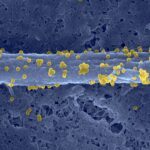Lien vers Pubmed [PMID] – 15882192
Clin Microbiol Infect 2005 Jun; 11(6): 430-6
Human listeriosis is caused by the Gram-positive bacterium Listeria monocytogenes. In humans, this pathogen has the ability to cross the intestinal, placental and blood-brain barriers, leading to gastroenteritis, maternofetal infections and meningoencephalitis, respectively. The entry of L. monocytogenes into cultured human epithelial cells is mediated by the interaction of an L. monocytogenes surface protein, internalin, with its human receptor, E-cadherin. The internalin-E-cadherin interaction is species-specific, and relies on the nature of a single amino-acid in the E-cadherin molecule, which is proline in permissive species such as humans, and glutamic acid in non-permissive species such as the mouse. In a transgenic mouse model that expresses human E-cadherin in enterocytes, internalin allows L. monocytogenes to cross the intestinal barrier. Epidemiological evidence also supports a role for internalin in human listeriosis, not only for crossing the intestinal barrier, but also for targeting and crossing the placental and blood-brain barriers. Consistent with these epidemiological data, infection with L. monocytogenes of trophoblastic cell lines, primary trophoblast cultures and human placental villous explants demonstrates that bacterial invasion of the syncytiotrophoblast barrier is mediated by the internalin-E-cadherin interaction, leading to histopathological lesions that mimic those seen in the placentas of women with listeriosis. Thus, the internalin-E-cadherin interaction that plays a key role in the crossing of the intestinal barrier in humans is also exploited by L. monocytogenes to target and cross the placental barrier. Further investigations are currently focusing on the molecular mechanisms by which L. monocytogenes targets and crosses the blood-brain barrier.

